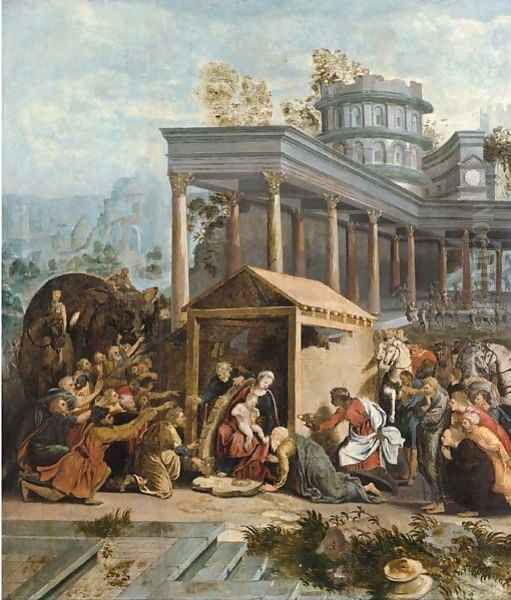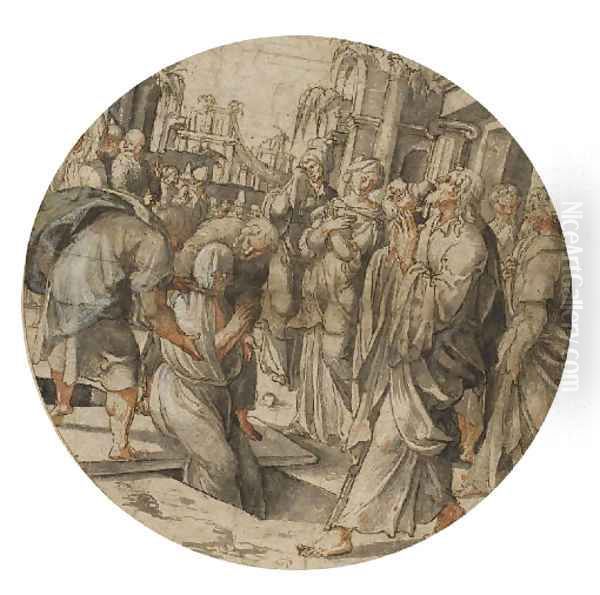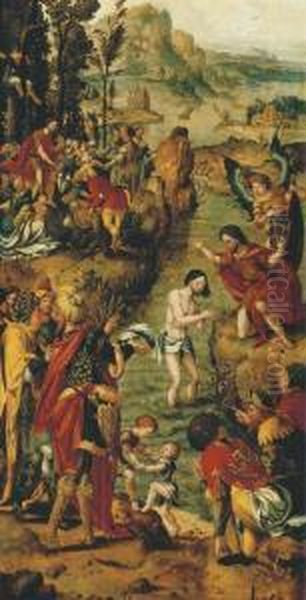The annals of art history are rich with figures whose contributions have shaped our understanding of specific eras and movements. Among the notable artists of the Northern Renaissance in the Low Countries, Jan Swart van Groningen emerges as a fascinating and somewhat enigmatic figure. Active during a period of profound artistic and cultural transformation, his work across various media, including painting, printmaking, and stained-glass design, reflects both the established traditions of Netherlandish art and the burgeoning influences from Renaissance Italy. This exploration delves into his life, his diverse artistic output, his stylistic characteristics, and his place within the vibrant artistic milieu of sixteenth-century Europe.
The Shifting Sands of Time: Pinpointing a Life
Establishing the precise biographical details of artists from centuries past often presents a challenge, and Jan Swart van Groningen is no exception. Historical records offer somewhat conflicting information regarding his birth and death dates. Some earlier accounts suggested a lifespan from 1469 to 1535. However, more recent scholarship, and a synthesis of available data, points towards a birth year around 1500 and a death year circa 1560. Sources also indicate his activity as an artist spanning from approximately 1500 until at least 1553, with some suggesting his death might have occurred around 1553 or 1558.
While the exact dates remain a subject of art historical discussion, the consensus leans towards him being a prominent figure of the first half and early mid-sixteenth century. His appellation "van Groningen" clearly links him to the city of Groningen in the northern Netherlands, suggesting it as his birthplace or a significant place of his early activity. Like many artists of his time, he was likely itinerant, working in various artistic centers, which was common for those seeking patronage and diverse commissions.
A Multifaceted Talent: Artistic Style and Versatility
Jan Swart van Groningen was not an artist confined to a single medium. His oeuvre demonstrates a remarkable versatility, encompassing panel paintings, designs for woodcuts, and, significantly, cartoons for stained-glass windows. This adaptability was a hallmark of many successful Renaissance artists, who often needed to cater to a wide range of patronal demands.

His stylistic approach is firmly rooted in the Northern Renaissance tradition, characterized by a meticulous attention to detail, a rich and often symbolic use of color, and a tendency towards narrative clarity. However, his work also shows an awareness of, and engagement with, the artistic innovations emanating from Italy. This is particularly evident in his figure drawing, which sometimes displays a more idealized and monumental quality reminiscent of Italian masters, and in his handling of perspective and architectural settings. It is believed he may have traveled to Italy, a common practice for ambitious Northern European artists seeking to study classical antiquity and the works of Italian Renaissance luminaries firsthand.
In his paintings, Swart often depicted religious scenes and, occasionally, mythological or allegorical subjects. His compositions are typically well-structured, guiding the viewer's eye through the narrative with a sure hand. There's a certain dramatic intensity in his work, conveyed through expressive figures and dynamic arrangements. His figures, while sometimes exhibiting a slightly elongated or mannered proportion, are rendered with a sensitivity that captures their emotional states. The landscapes in his paintings, whether as primary subjects or backgrounds, are often detailed and evocative, contributing significantly to the overall mood of the piece.
His work in printmaking, primarily woodcuts, allowed for a wider dissemination of his designs. These prints often share the narrative drive and compositional clarity of his paintings. The medium of woodcut, with its strong contrasts and linear emphasis, suited his clear storytelling style.
Illuminating Narratives: Key Works and Masterpieces
Several key works allow us to appreciate the scope and quality of Jan Swart van Groningen's artistry. These pieces, housed in various international collections, showcase his skill in different genres and themes.
One of his notable paintings is "The Triumph of Silenus," currently in the Kunsthistorisches Museum in Vienna. This work depicts a boisterous, Bacchic procession, with the elderly, intoxicated Silenus, a companion and tutor to the wine god Dionysus (Bacchus), as the central figure. The painting is a vibrant exploration of classical mythology, rendered with a Northern European sensibility. The figures are dynamic, the details are rich, and the overall atmosphere is one of revelry and earthly pleasure, a theme that gained popularity during the Renaissance as interest in classical subjects revived.

Another significant painting attributed to him is "Christ in a Landscape," housed in the Montreal Museum of Fine Arts. This work is a poignant depiction of Christ, likely in a moment of contemplation or prayer, set within an expansive and detailed natural environment. Such paintings reflect a Renaissance humanizing trend, where religious figures were often portrayed with greater psychological depth and in more relatable, naturalistic settings. The depiction of Christ holding a cross in some of his works has also been noted in discussions regarding the representation of Jewish identity within Christian art of the period, highlighting the complex iconographic layers present in his religious imagery.
"The Virgin and Child with Saints" (Städel Museum, Frankfurt) is another example of his religious painting, showcasing his ability to handle multi-figure compositions with grace and devotional feeling. The arrangement of figures, the interplay of gazes, and the careful rendering of drapery and attributes would have resonated deeply with contemporary viewers.
His woodcut series, "Suleiman and his Retinue" (1526), is a particularly interesting work. It depicts the Ottoman Sultan Suleiman the Magnificent and his entourage in a grand procession. This series reflects the European fascination with, and often apprehension of, the Ottoman Empire, which was a major political and military power at the time. Such prints served not only as artistic endeavors but also as a form of visual reportage or exotic curiosity for a European audience. The detail in costume and the attempt to capture the grandeur of the Ottoman court are noteworthy.
The painting "The Marriage at Cana," also attributed to Swart, further demonstrates his skill in depicting complex biblical narratives. This subject, a favorite in Christian art, allowed artists to showcase their ability in rendering festive scenes, numerous figures, and rich still-life details, all within a sacred context.
The Glow of Glass: Contributions to Stained-Glass Art
Jan Swart van Groningen's contributions to the art of stained glass are particularly significant. He is known to have produced designs, or cartoons, for stained-glass windows, a highly prestigious and technically demanding art form. His involvement in this medium is notably linked to the city of Gouda, which became famous for the magnificent stained-glass windows of its Sint-Janskerk (St. John's Church).

He is documented as having collaborated with the renowned Gouda glass painters Dirck Crabeth I and his brother Wouter Crabeth I. The Crabeth brothers were leading figures in the creation of the Gouda windows, a monumental project that spanned several decades in the mid-sixteenth century. Swart's designs would have provided the compositional framework and iconographic program for some of these windows. His ability to create clear, legible, and aesthetically powerful designs suitable for translation into the luminous medium of glass underscores his versatility and his understanding of different artistic requirements. The designs for stained glass needed to be bold and readable from a distance, and Swart's narrative clarity would have been well-suited to this purpose.
Currents of Influence: The Italian Journey and Netherlandish Roots
The artistic development of Jan Swart van Groningen was shaped by several key influences. As mentioned, a potential journey to Italy would have exposed him to the monumental forms, classical themes, and advanced understanding of anatomy and perspective prevalent in Italian Renaissance art. This "Romanism," as the adoption of Italianate styles by Northern artists came to be known, was a significant trend in sixteenth-century Netherlandish art. Artists like Jan Gossaert (Mabuse), Bernard van Orley, and later Maarten van Heemskerck were pivotal in introducing and popularizing these Italianate elements.
Within the Netherlandish context, Swart's style shows affinities with, and was likely influenced by, prominent contemporaries. The work of Jan van Scorel (1495-1562), a key figure in introducing Italian Renaissance ideals to the Northern Netherlands, particularly after his own travels to Italy (where he even briefly served as curator of the Vatican collection), would have been a significant presence. Scorel’s sophisticated compositions, idealized figures, and atmospheric landscapes set a new standard.
Another important contemporary whose work bears some relation to Swart's is Pieter Coecke van Aelst (1502-1550). Coecke was an incredibly versatile artist, active as a painter, tapestry designer, print publisher, and architect. He, too, traveled to Italy and later to Constantinople, and his work is characterized by an elegant, somewhat mannered Italianism. It is noted that some of Swart's designs were copied or adapted by Pieter Coecke, particularly for use in tapestries, indicating a recognized quality and appeal in Swart's inventions. This also suggests a dynamic artistic environment where designs and motifs circulated and were reinterpreted across different media.
A Constellation of Talent: The Northern Renaissance Artistic Landscape
Jan Swart van Groningen operated within a vibrant and competitive artistic landscape. The early to mid-sixteenth century in the Low Countries was a period of immense artistic production, with major centers like Antwerp, Bruges, Brussels, Haarlem, and Utrecht fostering distinct schools and workshops.
Beyond Jan van Scorel and Pieter Coecke van Aelst, numerous other painters were active during or overlapping with Swart's career, creating a rich tapestry of artistic endeavor:

Lucas van Leyden (c. 1494–1533): A precocious genius, primarily known for his highly accomplished engravings and woodcuts, but also a gifted painter. His prints were widely influential throughout Europe.
Joachim Patinir (c. 1480–1524): A pioneer of landscape painting as an independent genre. While his career ended relatively early in Swart's active period, his innovative approach to landscape would have influenced subsequent generations.
Quentin Matsys (c. 1466–1530): A leading painter in Antwerp during the early sixteenth century, known for his religious paintings and satirical genre scenes, bridging late Gothic traditions with Renaissance sensibilities.
Jan Gossaert (Mabuse) (c. 1478–1532): One of the earliest Netherlandish "Romanists," who traveled to Rome and profoundly influenced the introduction of Italian Renaissance motifs and mythological subjects into Northern art.
Bernard van Orley (c. 1487/1491–1541): A leading artist in Brussels, court painter to Margaret of Austria and Mary of Hungary. He was highly versatile, producing paintings, tapestry designs, and stained-glass cartoons, often in a sophisticated Italianate style.
Maarten van Heemskerck (1498–1574): A student of Jan van Scorel, Heemskerck became one of the most important Netherlandish painters to fully embrace and disseminate an Italianate style after his own extensive stay in Rome, where he meticulously sketched ancient ruins. His powerful, muscular figures and dramatic compositions were highly influential.
Dirck Bouts (c. 1410/1420 – 1475): While from an earlier generation, Bouts's solemn, deeply spiritual style and his innovations in perspective and portraiture, particularly in Leuven, laid foundational groundwork for later Netherlandish painting. His influence, and that of other Early Netherlandish masters like Jan van Eyck and Rogier van der Weyden, continued to resonate.
Jan Mostaert (c. 1475 – 1555/1556): Active primarily in Haarlem, Mostaert was known for his portraits and religious scenes, including one of the earliest depictions of the "New World" in his West Indies Landscape.
Ambrosius Benson (c. 1495/1500 – 1550): An Italian-born painter who became a citizen of Bruges, Benson was a prolific producer of religious paintings and portraits, often characterized by strong colors and somewhat robust figures.
Adriaen Isenbrandt (c. 1480/1490 – 1551): Active in Bruges, Isenbrandt continued the stylistic traditions of earlier Bruges masters like Gerard David, producing refined and devotional religious works.
Marten de Vos (1532–1603): Though his main period of activity is slightly later than Swart's, de Vos represents the continuation and further development of the Italianate tradition in Antwerp, becoming one of the leading history painters of the later sixteenth century. His early career would have overlapped with Swart's later years.
This list is by no means exhaustive but illustrates the rich artistic environment. Artists often belonged to guilds, such as the Guild of Saint Luke, which regulated the profession, provided training, and fostered a sense of community, albeit one often marked by professional rivalries.
Intersections and Legacies: Cooperation, Influence, and Competition
The art world of the sixteenth century was a network of influences, collaborations, and, undoubtedly, competitions. Direct evidence of Jan Swart van Groningen's competitive relationships with specific artists is scarce, as such interactions are often not explicitly documented. However, the very nature of seeking commissions and patronage implies a competitive environment.
His collaboration with the Crabeth brothers in Gouda is a clear instance of cooperative endeavor, where his design skills were paired with their mastery of glass painting techniques. This was a common model, where painters or designers provided cartoons for execution by specialized craftsmen in other media, like tapestry weavers or glass painters.
The relationship with Pieter Coecke van Aelst appears to be one of mutual awareness and influence. If Coecke adapted Swart's designs, it suggests respect for Swart's inventive capabilities. Conversely, Swart was likely aware of Coecke's prominent position and his role in disseminating Italianate forms.
The broader influence of figures like Jan van Scorel on the artistic climate of the Northern Netherlands would have undoubtedly impacted Swart. Scorel's workshop and his widely admired style set a benchmark. While it's not explicitly stated that Swart was a direct pupil of Scorel, he would have been working within an artistic sphere shaped by Scorel's innovations. Similarly, the pervasive influence of earlier masters like Dirck Bouts or the printmaking prowess of Lucas van Leyden would have formed part of the visual and technical vocabulary available to an artist like Swart.
Regarding Maarten van Heemskerck, who was a pupil of Scorel, their paths might have crossed, especially if Swart was active in artistic centers like Haarlem or Antwerp where Heemskerck also worked. Both artists engaged with Italianate forms, though Heemskerck's style became more pronouncedly muscular and dramatic after his Roman sojourn.
The absence of detailed records makes it difficult to ascertain specific competitive dynamics with artists like Marten de Vos (whose main impact was slightly later) or the earlier Dirck Bouts. However, all artists vied for the attention of patrons, whether they were civic bodies, religious institutions, or wealthy private individuals. Success often depended on a combination of skill, innovation, connections, and the ability to adapt to changing tastes.
An Enduring Mark on Netherlandish Art
Jan Swart van Groningen, though perhaps not as universally recognized today as some of his towering contemporaries like Dürer, Holbein, or Bruegel, was nonetheless a significant and skilled artist of his time. His versatility across painting, printmaking, and stained-glass design speaks to his adaptability and talent. His work embodies the transitional character of the Northern Renaissance, retaining the detailed realism and narrative focus of Netherlandish tradition while engaging with the formal innovations and thematic interests of the Italian Renaissance.
His contributions to the magnificent stained-glass windows of Gouda, his evocative religious and mythological paintings, and his intriguing prints like the "Suleiman" series, all secure his place in the history of Netherlandish art. He was part of a dynamic generation of artists who navigated a period of immense religious, intellectual, and social change, reflecting these transformations in their work. Further research and potential new attributions may continue to shed more light on this intriguing master from Groningen, allowing for an even fuller appreciation of his artistic legacy. His oeuvre remains a testament to the rich artistic ferment of the sixteenth-century Low Countries.